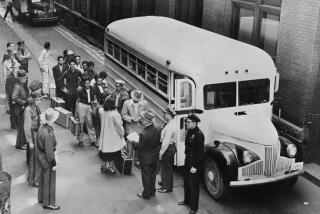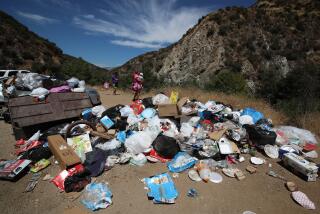U.S. Park’s Men Try to Put Juan Together Again
- Share via
Juan Rodriguez Cabrillo is going the way of all flesh, a victim of salt crystallization, “visitor abuse” and maybe the fallout from a few thousand jets.
A chunk of his tunic has chipped off. His aquiline nose is cracked across the bridge. Now an old injury--a torso break--is acting up, raising questions about tourist safety in an earthquake.
So the seven-ton stone man is retiring after 37 years of surveying San Diego Bay from Point Loma. The National Park Service figures 40 million people have admired his physique, commemorating the first European to discover what is now California.
This week, the service expects to complete guidelines for moving the sculpture inside the museum at Point Loma. There, the chief conservator for the Park Service eventually will go to work with poultices and resins, patching up Cabrillo’s aching constitution.
Meanwhile in Portugal, sculptor Charters Almeida expects to finish a replica of the statue by late February, said Doris Omundson, superintendent of Cabrillo National Monument. Carved out of more durable limestone, it will be brought to Point Loma to take the place of the original statue.
“It was with a great deal of reluctance that any decision was made to move the piece indoors,” said Gregory Byrne, chief conservator for the Park Service in Harpers Ferry, W.Va. “ . . . But the conclusion of many experts was that, if it continued to remain outside, we would lose it.”
The statue’s problems stem from the soft, porous limestone it was carved out of in Portugal in the late 1930s. A gift from Portugal to California, it broke in half before it even reached the West Coast, and has been deteriorating ever since.
First, it has been damaged by briny ocean air at the monument, one of the most popular national monuments after the Statue of Liberty. Moist air penetrates the stone and dissolved salts crystallize inside, expanding and slowly chipping off layers of stone.
The statue also suffers from what Byrne called “visitor abuse”--tourists mauling it, climbing on it, and pocketing loose bits. Many of the broken chunks have been saved by the Park Service and will be put back on during the restoration.
Finally, it appears to have been eroded by acid rain, Byrne said. He speculated that the damage may have been done by sulfuric acid--a product of hydrocarbon combustion in the engines of the jet planes that constantly pass overhead.
The Park Service considered several options, said Omundson, including building some sort of case for the statue. But it concluded that the prevailing weather would produce a greenhouse effect, fogging the windows and leaving the statue in steamy isolation.
So it opted to move the explorer inside. There, Byrne will set to work restoring the statue, first soaking out soluble salts using a series of poultices. Then he will perform “cosmetic treatment,” filling holes and cracks and replacing chipped chunks.
He intends to work with early documentary photographs that vividly illustrate the statue’s decay.
“There won’t be any conjecture used in any cosmetic work,” he said. “Everything will be documented, or we wouldn’t do it.”
Everything, too, will be reversible, lest conservators later discover that Byrne’s materials have discolored or turned out to be unstable.
Finally, the refurbished sculpture will be exhibited in the little museum at the monument. Byrne would like to see it displayed without a pedestal so visitors will be able to appreciate it more as a piece of sculpture than as a monument.
The statue, which is 12 feet tall, was carved in the late 1930s by Portuguese sculptor Alvaro deBree in commemoration of Cabrillo’s arrival in the bay in 1542. The Portuguese explorer sailed under the Spanish flag and died just months after visiting what is now San Diego Bay.
The statue was shipped west for an exposition in San Francisco in 1940 but never went on display. Instead, it ended up in a garage in San Francisco, after the exposition committee turned it over to the state in order to avoid paying customs duties.
It was discovered there by Lawrence Oliver of San Diego, who with the help of then state Sen. Ed Fletcher, brought the statue to San Diego. It was initially placed on the bay at water level, then moved up to Point Loma during World War II to clear out space for the Navy.
“I will say that in looking at it two times over the course of three years that I have photographically recorded more deterioration . . . more loss,” said conservator Byrne. “It’s a common occurrence that if you live with a piece of sculpture and see it every day, you don’t see it deteriorating.”
More to Read
Sign up for The Wild
We’ll help you find the best places to hike, bike and run, as well as the perfect silent spots for meditation and yoga.
You may occasionally receive promotional content from the Los Angeles Times.






